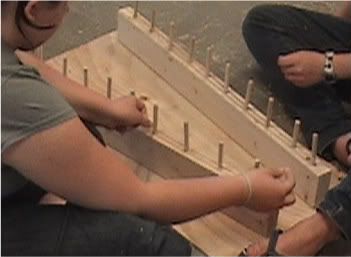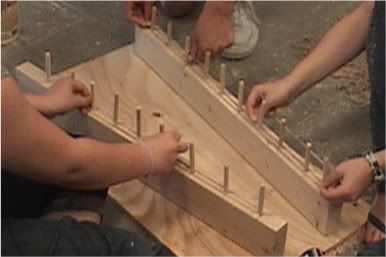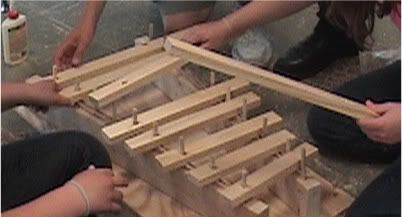Xylophones
Xylophones are actually a set of instruments — a row of narrow boards tuned to single notes, rather like a set of panpipes. They’re easy to make and sound great even if they’re not tuned — but they’re not that hard to tune, and tuning is fun as long as you don’t spend your whole day doing it.
Get a piece of scrap board and attach two short lengths of scrap 2×4 to it, one parallel to the edge, one at a slight angle, so that the space between the 2x4s gradually narrows. This is the frame of your xylophone. Find some narrow scrap wood and cut a set of graduated lengths. These are your keys. The keys need to be about 1 2/3 of the spaces between the 2x4s (if the space narrows from 15 inches to 9 inches, your keys will need to range from 25 inches to 15 inches). If your measurements are a little off, no problem.
Line the keys up on the 2x4s, and mark their locations. Drill some 1/2′ diameter holes between the key positions on one side, and in the middle of the key positions on the other side. Cut some 1/2″ dowels to about 4″ long and glue them in the holes.
Drill 5/8″ holes in one end of each key, about 1/5 of the way in from the end.
Using rubber bands, old foam rubber, or pieces of sponge, create a bouncy surface at the top of the 2x4s.


Put the keys on; the 5/8″ hole goes over the dowel that’s in “mid-key” position.


Xylophone keys are easy to tune. Using a file, remove wood a little bit at a time from the middle of the key, on the underside. This will make the note flatter. Try not to overshoot your destination tone, because making the keys sharper (by removing wood from the ends instead) is much more time-consuming. Tune it so it sounds good to your ear. Take some rubber bands and wrap them around some sticks to make mallets, or use a long length of glue-soaked string for a harder surface.